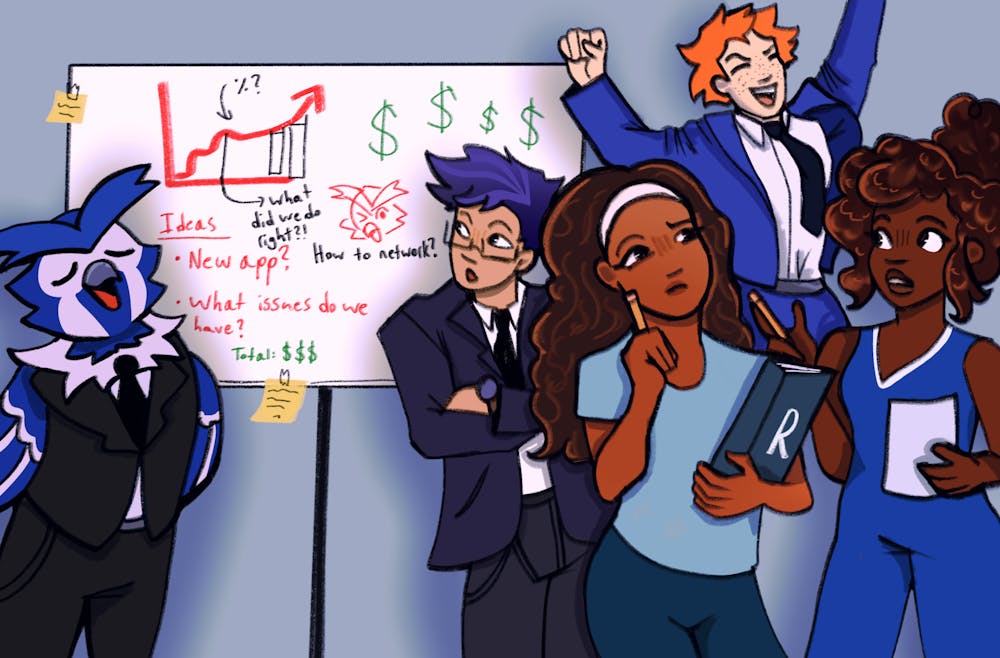Owls in business: Student founders to watch out for

Abby Perez / Thresher
#1. Kaducia - Samek Rangarajan
Samek Rangarajan might not be a doctor, but he is already tackling the inefficiencies of healthcare billing and insurance claim denials. His platform Kaducia is designed to help doctors spend less time on insurance paperwork and more time with patients.
“The American health insurance system is something of an IQ test, and I don’t think that’s right,” said Rangarajan, a McMurtry College senior. “Everyone should be able to access healthcare.”
Rangarajan joined Rice’s Liu Idea Lab for Innovation and Entrepreneurship Summer Venture Studio this summer, where he refined Kaducia’s business model, connected with mentors and gained support from the Harris County Medical Society and other community partners. The experience also changed his perspective on what it means to build a company.
“I definitely came in most excited about the coding, [but] coding is maybe like 10% of the job of a founder,” Rangarajan said. “Most of the work is going to be on customer development, business development, sales, actually getting to the real problems people are facing.”
Rangarajan shadowed billing workflows in five clinics to understand pain points firsthand, and he translated those insights into a three-phase rollout plan: back-testing old data, piloting with a small group of physicians and expanding to full organizationwide implementation.
In its first pilot, Kaducia backtested several months of claims with a partner clinic, uncovering errors that would have led to costly denials. Rangarajan said that is evidence of the platform’s potential to save providers time and money.
“I’m confident someone is going to fix this space and make it easier for people to access healthcare, to bring down claim denials and to modernize a very broken, antiquated system,” Rangarajan said. “Maybe it will be Kaducia. I’m hopeful. But I’m certain that change is coming.”
#2. Hira - Sathya Padmanabhan and J.W. Aguirre
Hira was created by Sathya Padmanabhan and J.W. Aguirre to address a problem familiar to many college students: the time-consuming process of job applications. Padmanabhan, a Brown College junior, said hours spent filling out repetitive forms and tailoring cover letters highlighted the need for a more efficient approach.
“[Job applications] are taking way too long,” said Padmanabhan. “My friend J.W. comes to me with the same problem, and we talked to our friends and realized everyone has the same issue. Everyone hates job applications.”
Hira uses artificial intelligence to fill out job applications, requiring only a resume and a short profile. The system automatically finds roles, matches them to user experience and completes applications.
Padmanabhan said building Hira meant making a bold choice with their summer plans. Instead of pursuing internships, he and Aguirre, a Lovett College junior, rented an Airbnb in Dallas and spent the summer coding day and night.
“I wish I was joking, but we honestly stayed up 12 to 14 hours every single day to work on this,” Padmanabhan said. “We enjoy working on it so much that it doesn’t feel like work, it feels fun.”
After a rough first launch, the team decided to scrap two months of work and rebuild the product in only a few days.
“Right when we launched it, nothing worked, everything broke, it all fell apart,” Padmanabhan said. “We sat there for two days straight, rebuilt our whole thing, and … once we launched that, we saw a lot more growth and a lot of people started coming to our website.”
Padmanabhan said Hira grew to 1,200 users, processed nearly 5,000 applications and generated revenue in the first few weeks after its launch.
This fall, Padmanabhan and Aguirre are taking Hira to Rice’s Lilie New Venture Challenge class, with plans to refine the platform further and release new features, such as giving users control over which jobs are applied to. They said positive feedback has reinforced their commitment to providing an easy-to-use service to their classmates and others on the job search.
“When people reach out like that, it feels validating,” Padmanabhan said. “It just motivates us more.”
#3. Haast Autonomous - Ege Halac, Jason Chen, Santiago Brent
When lives are on the line, even a traffic jam can make the difference. Haast Autonomous is betting that pilotless aircraft can cut through the gridlock, delivering organs, blood and other critical supplies faster than today’s outdated courier systems.
The idea began with Ege Halac, a Baker College junior, during his research at Houston Methodist. He noticed a troubling gap: plenty of organs were available for patients, but inefficient transport often kept them from arriving in time.
Halac immediately called on his two friends, Jason Chen and Santiago Brent, both Will Rice College seniors with a shared interest in transportation technologies. Together, the trio saw an opportunity to merge engineering with a critical medical need.
“I really think the combination of disciplines we have is super beneficial not only to the work we do but also to the speed and efficiency with which we’re able to work,” Brent said.
Haast’s vision is to reimagine how lifesaving materials move through the Texas Medical Center and beyond. Rooftop helipads and other infrastructure already exist but are rarely used for organ transport.
Their approach combines hardware and software into a full-service model. Aircrafts are designed for vertical takeoff and long-range flight and can take the organ every step of the way, but Brent said building the aircraft is only half the battle. To move past the regulatory hurdles, the team is partnering with one of the seven unmanned aircraft systems test sites in the country, where they hope to prove the safety and reliability of their system.
“The biggest hurdle for us is the [Federal Aviation Administration] and getting these waivers to fly,” Brent said.
That progress has been fueled in part by support from Lilie, where the team joined the Summer Venture Studio.
“You run into a lot of unforeseen things, and having someone who’s been through the mud before is really helpful,” Brent said of Lilie. “Being in a cohort of other startups fighting the same battle is inspiring and motivating.”
For Chen, the best part of his work has been the people.
“Being able to work with people who are super passionate has been incredible,” he said. “We were all friends to begin with, and setting our own goals and the impact we want to make, then combining that into something meaningful and new — it’s been exciting to see what happens when disciplines collide.”
#4. SlayAI - Rahul Shah
Finding clothes online often starts with guesswork: vague search terms, endless scrolling and mixed results. Rahul Shah, a Martel College junior, started SlayAI to cut through that frustration with a mobile app that lets users snap a photo of clothing and instantly discover where to buy it. By breaking images into key terms and scanning Google Shopping and Google Images, the app delivers accurate, shoppable matches in seconds.
Shah said the idea for SlayAI came from one particularly fruitless search of his own.
“I just remember watching a TV show and thinking the main character had a really, really cool sweater. I couldn’t find it anywhere, I kept searching ‘blue ribbed sweater, frayed neckline’ and nothing came up. And I thought, surely there’s a better way to do this.” said Shah, a Martel College junior.
Since its App Store launch, SlayAI has been downloaded more than 5,000 times, with most of its growth fueled by TikTok. Two influencer partnerships drove viral spikes, including one video that reached 250,000 views and another that topped 50,000. That attention boosted its visibility even further, pushing SlayAI to the top of App Store searches for phrases like “clothing scanner.”
Shah said the most rewarding part has been seeing the app in use.
“Seeing user requests in real time and watching people actually use and enjoy the app is really, really fulfilling,” said Shah.
More from The Rice Thresher

Sree’s Tiffin feeds a community of cravings
Of all the common sicknesses Rice undergraduate students face, none is more widespread than homesickness. Trisha Rangi said she understands what it’s like to miss things that feel like home, and she decided to do something about it.

New student center to ‘complete’ central quad
Breezeways, arches and outdoor seating will abound at the Moody Center Complex for Student Life set to break ground May 8. The 75,000-square-foot complex was designed by architecture firm Olson Kundig and has an expected completion date of fall 2027.

Best study snacks to fuel your finals
Finals are creeping up on us, and that means hunting season for the best study snacks on and off campus. Below are some that are sure to see you through the most enigmatic paper prompts and puzzling practice questions.

Please note All comments are eligible for publication by The Rice Thresher.